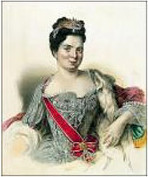
The first Russian Empress Catherine I was born
On April 5 (15), 1684 in Swedish Livonia in a family of peasants was born Marta Samuilovna Skavronskaya, the second wife of Peter the Great, future empress of Russia Catherine I (Yekaterina Alexeevna).
During her youth Marta Skavronskaya lived in the house of pastor Gluck in Marienburg where she worked as a cook and a laundress. In 1702 when Marienburg was seized by the Russian troops the future Russian empress was taken as a trophy and found herself in the train of Peter’s associate, count B. P. Sheremetev, then prince A. D. Menshikov. In 1703 Peter I took Marta from the prince and made her one of the waiting-ladies of Tsesarevna Natalya in Preobrazhensky village. Here she was converted to Orthodoxy and named Yekaterina Alexeyevna because her godfather was Peter’s I son tsarevich Alexei. Catherine had a cheerful, tender and equal temper, she easily adjusted to Peter’s caprices, accepted his fits of causeless anger, helped him when he had his epilepsy attacks and shared the hardship of field life. She never participated directly in the discussion of political issues, but had a certain impact on tsar and often stood up for A. D. Menshikov.
On his return from Pruth campaign to Petersburg in February of 1712 Peter got married in church with Catherine. Their daughters Anna and Elisabeth officially became Tsesarevnas. In 1714 in memory of Pruth campaign tsar instituted the Order of Saint Catherine which he awarded to his wife on her name day. In May of 1724 Peter crowned Catherine as the Empress in the Dormition Cathedral in Moscow.
After Peter’s death in 1724 Catherine I mounted the throne supported by A. D. Menshikov, the Guards and the garrison of Petersburg. In February of 1726 in her reign was created the Supreme Privy Council which included princes A. D. Menshikov and D. M. Golitsyn, counts F. M. Apraksin, G. I. Golovkin, P. A. Tolstoy and baron G. I. F. Osterman. The Council was established as an advisory body but in fact it ruled the country and decided all the important state issues.
During the reign of Catherine I was opened the Imperial Academy of science, organized the research expedition of Vitas Bering to Kamchatka, established the Order of Saint Alexander Nevsky and concluded the alliance with Austria. Not long before her death Catherine, on insistence of A. D. Menshikov, signed the will leaving the throne to a young grandson of Peter I, grand duke Pyotr Alexeevich, the future Russian emperor Peter II.
On May 6 (17), 1727 at the age of 43 Empress Catherine I died and was buried in the burial vault of the Russian emperors in Peter and Paul Cathedral in St.-Petersburg.
Lit.: Анисимов Е. В. Женщины у власти в XVIII в. как проблема // Вестник истории, литературы, искусства. Отделение историко-филологических наук РАН. М., 2005. С. 328-335; Из ольденбургского великогерцогского архива // Русский архив. 1904. № 1; Павленко Н. И. Екатерина I. М., 2009; Царица Екатерина Алексеевна, супруга Петра Великого в 1707-1713 гг. // Русская старина. 1880. Т. 28. № 8. С. 753-756; Соловьёв С. М. Сочинения. Кн. 9. Т. 18. М., 1998. Гл. 4. Царствование императрицы Екатерины I Алексеевны; То же [Электронный ресурс]. URL: http://militera.lib.ru/common/solovyev1/18_04.html; Шорникова И. Н. Звёздные часы императриц: Екатерина I, Анна Иоанновна, Елизавета и Екатерина II. Рязань, 1995.
См. также в Президентской библиотеке:
Catherine I (1684–1727) // House of Romanov. The Zemsky Sobor of 1613: [digital collection];
Арсеньев К. И. Царствование Екатерины I. СПб., 1856;
Основано Царское Село // День в истории. 5 июля 1710 г.;
Планы и чертежи Министерства Императорского Двора. Гравюры «Коронование Екатерины I». 1725 г.;

